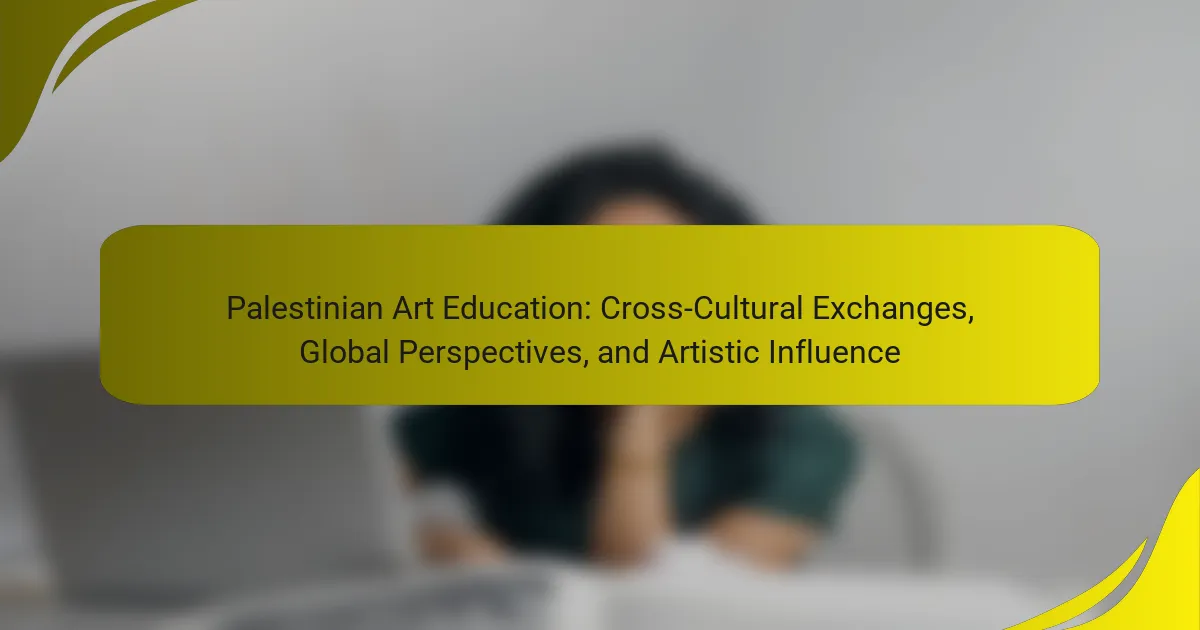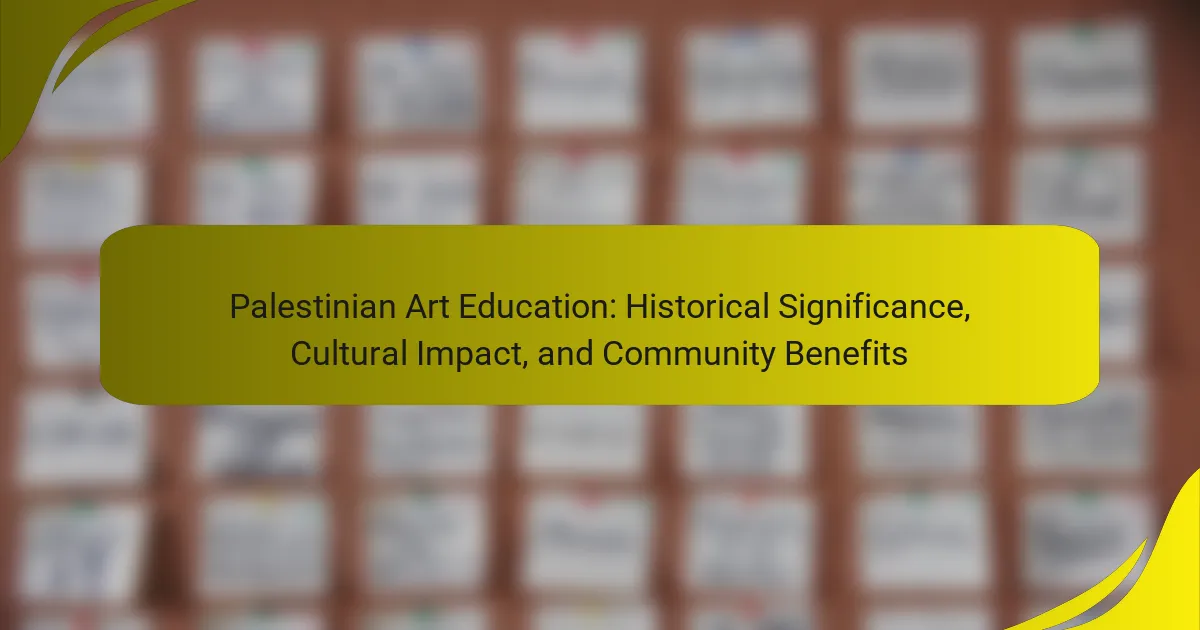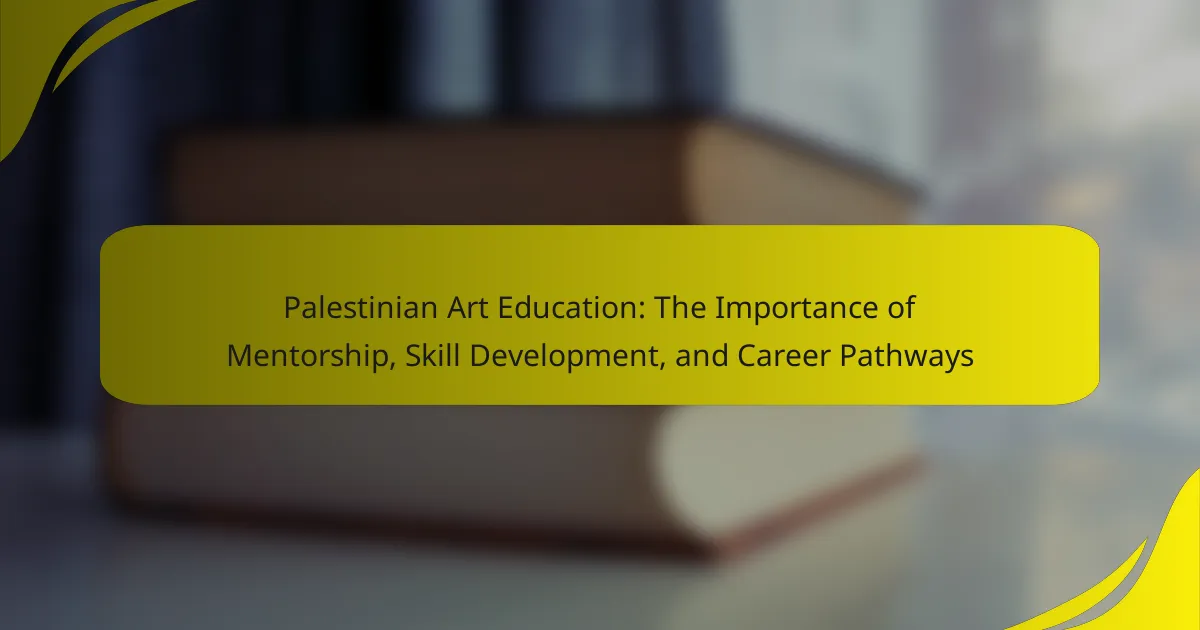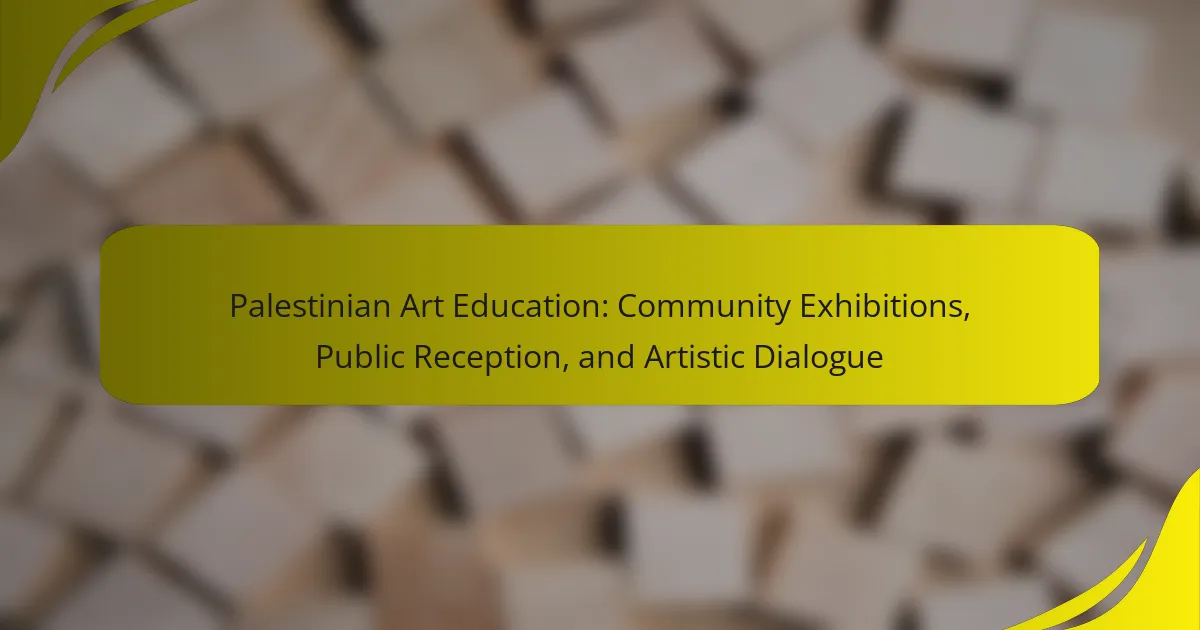Palestinian Art Education focuses on the teaching and practice of artistic disciplines within Palestinian communities, including visual arts, music, and performance. This educational framework aims to enhance creativity and cultural identity among Palestinian youth by integrating local history and social issues into its curriculum. Key components of Palestinian Art Education include workshops, collaborative projects, and partnerships with local artists and organizations, which enrich the learning experience. Additionally, this form of education acts as a means of cultural preservation and resistance, fostering dialogue and understanding through artistic engagement.
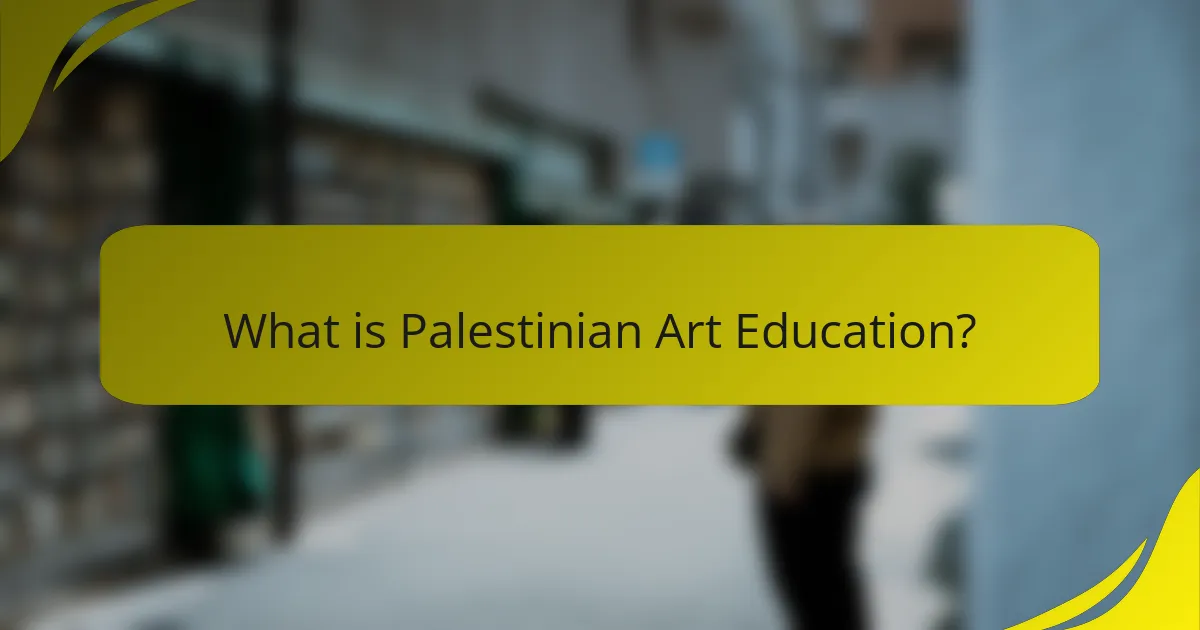
What is Palestinian Art Education?
Palestinian Art Education refers to the teaching and practice of art within Palestinian communities. It encompasses various forms of artistic expression, including visual arts, music, and performance. This education aims to foster creativity and cultural identity among Palestinian youth. It often incorporates local history and social issues into the curriculum. Workshops and collaborative projects are common methods used in this educational framework. Local partnerships with artists and organizations enhance the learning experience. Palestinian Art Education also serves as a means of resistance and cultural preservation. It promotes dialogue and understanding through artistic engagement.
How does Palestinian Art Education manifest in local communities?
Palestinian Art Education manifests in local communities through workshops, collaborative projects, and partnerships. These initiatives often involve community members of all ages, fostering creativity and cultural expression. Workshops are frequently organized in schools and community centers, providing hands-on learning experiences. Collaborative projects often include local artists working alongside students to create public art. Partnerships with NGOs enhance resources and outreach, expanding access to art education. This approach not only promotes artistic skills but also strengthens community bonds. Evidence of this impact can be seen in various art festivals and exhibitions held in Palestinian territories, showcasing local talent and creativity.
What are the key elements of Palestinian Art Education?
Key elements of Palestinian Art Education include community engagement, cultural identity, and creative expression. Community engagement fosters collaboration through workshops and projects. Cultural identity emphasizes the significance of local heritage in artistic practices. Creative expression allows individuals to explore personal and collective narratives. These elements collectively contribute to a robust framework for art education in Palestine. They reflect the unique socio-political context and the importance of resilience in artistic endeavors.
How does cultural heritage influence Palestinian Art Education?
Cultural heritage significantly influences Palestinian Art Education by shaping its themes and methodologies. Artistic practices often reflect the rich history and traditions of Palestinian society. This connection fosters a sense of identity among students and artists. Workshops frequently incorporate traditional techniques and narratives. Collaborative projects emphasize community stories and shared experiences. Local partnerships enhance the accessibility of art education. Cultural heritage provides a framework for understanding contemporary issues. This integration enriches the educational experience and promotes cultural preservation.
Why are workshops important in Palestinian Art Education?
Workshops are crucial in Palestinian Art Education as they foster creativity and skill development. They provide hands-on experience for students, enhancing their artistic abilities. Workshops also encourage collaboration among artists and students. This collaboration promotes cultural exchange and community engagement. Furthermore, workshops often address local themes and issues, making art relevant to participants. They serve as platforms for expression and dialogue in a challenging socio-political context. Evidence shows that such interactive learning environments improve student motivation and retention in art programs.
What types of workshops are commonly held?
Common types of workshops held in Palestinian art education include painting, sculpture, photography, and digital art. These workshops often focus on skill development and creative expression. They are designed for various age groups and skill levels. Collaborative projects frequently occur, promoting community engagement. Additionally, workshops may emphasize cultural heritage and social issues. Evidence shows that such workshops enhance artistic skills and foster local partnerships. They contribute to a vibrant art scene in Palestine, as supported by programs from local art organizations.
How do workshops enhance artistic skills among participants?
Workshops enhance artistic skills among participants by providing structured learning environments. Participants receive hands-on experience in various art techniques. They engage with experienced instructors who offer personalized feedback. Workshops also foster collaboration, allowing participants to learn from each other. This interaction encourages the exchange of ideas and techniques. Studies show that practical engagement improves skill retention. Additionally, workshops often culminate in presentations, boosting confidence in artistic abilities. These factors collectively contribute to the enhancement of artistic skills.
What role do collaborative projects play in Palestinian Art Education?
Collaborative projects play a crucial role in Palestinian Art Education. They foster community engagement and cultural exchange among artists and students. These projects often involve partnerships with local organizations and international entities. They provide resources and support that enhance artistic skills and knowledge. Collaborative efforts also help to address social issues through art. For example, projects may focus on themes of identity, resistance, and heritage. Additionally, they create platforms for showcasing Palestinian art on a broader scale. Evidence shows that such collaboration boosts creativity and innovation among participants. Overall, collaborative projects significantly enrich the educational landscape for Palestinian artists.
How are collaborative projects structured within the community?
Collaborative projects within the community are structured through organized partnerships and defined roles. These projects typically involve local artists, educators, and community members. Each participant contributes specific skills and resources. Communication channels are established to ensure effective collaboration. Regular meetings facilitate planning and feedback. Projects often align with community needs and cultural contexts. Funding sources may include grants and local sponsorships. Documentation of progress and outcomes is maintained for evaluation.
What are the outcomes of successful collaborative projects?
Successful collaborative projects lead to enhanced creativity and innovation. They foster diverse perspectives that contribute to unique solutions. Increased resource sharing is another outcome, allowing access to tools and expertise. Collaborative projects also build stronger relationships among participants. These relationships can lead to future partnerships and opportunities. Additionally, they often result in improved skills and knowledge for all involved. Evidence shows that projects with collaboration yield higher satisfaction rates among participants. Studies indicate that collaborative efforts can significantly boost community engagement and support.
How do local partnerships contribute to Palestinian Art Education?
Local partnerships enhance Palestinian art education by providing resources, expertise, and community engagement. These collaborations often involve local artists, cultural organizations, and educational institutions. They facilitate workshops that promote artistic skills and cultural expression. For instance, partnerships with NGOs can offer funding and materials for art programs. Additionally, local artists contribute their knowledge and mentorship to students. This hands-on experience enriches the educational landscape. Research indicates that such collaborations increase student participation and creativity in art. Overall, local partnerships play a crucial role in fostering a vibrant art education environment in Palestine.
What types of organizations typically partner with art educators?
Art educators typically partner with non-profit organizations, cultural institutions, and educational institutions. Non-profit organizations often focus on community engagement and outreach programs. Cultural institutions, such as museums and galleries, provide resources and venues for art education. Educational institutions include schools and universities that seek to enhance their art curricula. These partnerships are essential for promoting art education and fostering creativity. Collaborative projects often emerge from these partnerships, benefiting both educators and the organizations involved.
How do these partnerships impact the sustainability of art programs?
Partnerships enhance the sustainability of art programs by providing essential resources and support. They facilitate funding, which is critical for ongoing operations. Collaborations with local organizations often lead to shared expertise and expanded outreach. This can increase community engagement and participation in art initiatives. Partnerships also enable access to diverse audiences, which helps in building a robust participant base. Moreover, they can foster innovation through the exchange of ideas and practices. Evidence shows that art programs with strong partnerships are more likely to thrive long-term. For instance, studies indicate that collaborative projects in education often yield higher retention rates and participant satisfaction.
What challenges does Palestinian Art Education face?
Palestinian Art Education faces significant challenges related to political instability and limited resources. Political conflicts restrict access to educational facilities and materials. Many art educators struggle to find funding for programs and workshops. The lack of infrastructure hinders the development of comprehensive art curricula. Additionally, cultural restrictions can limit artistic expression and exploration. The ongoing occupation creates an environment of uncertainty for students and teachers alike. These factors collectively impact the quality and accessibility of art education in Palestinian territories.
How do socio-political factors influence art education initiatives?
Socio-political factors significantly influence art education initiatives by shaping the context in which they operate. In regions like Palestine, political instability affects funding for educational programs. Limited resources can hinder the development of art initiatives. Additionally, socio-political narratives often dictate the themes explored in art education. For example, workshops may focus on identity and resistance due to the ongoing conflict. Collaborations with local organizations can also be impacted by political affiliations and regulations. These factors can either facilitate or restrict community engagement in art education. Ultimately, the socio-political landscape directly affects the accessibility and relevance of art education initiatives.
What strategies can be employed to overcome these challenges?
Engaging local communities through collaborative projects can effectively overcome challenges in Palestinian art education. These projects foster inclusivity and encourage participation from diverse groups. Establishing partnerships with local organizations enhances resource sharing and support. Workshops that focus on hands-on learning provide practical skills and boost creativity among participants. Utilizing digital platforms for remote learning expands access to art education. Additionally, promoting cultural exchange programs helps to broaden perspectives and build networks. Investing in training for local educators ensures sustained quality in teaching practices. These strategies collectively address the barriers faced in art education within Palestinian communities.
What best practices can enhance Palestinian Art Education initiatives?
Integrating community engagement is a best practice that can enhance Palestinian Art Education initiatives. This involves actively involving local artists and community members in the educational process. Collaborative art projects can foster a sense of ownership and relevance in the curriculum. Workshops led by established artists can provide mentorship and skill development. Incorporating local cultural themes into art education can make learning more relatable and impactful. Utilizing digital platforms for sharing artwork can broaden exposure and appreciation. Establishing partnerships with local organizations can provide resources and support. Funding opportunities through grants can facilitate program sustainability. Regular feedback from participants can help tailor initiatives to community needs.
How can educators effectively engage the community in art education?
Educators can effectively engage the community in art education by organizing collaborative projects and workshops. These initiatives foster participation from local artists and community members. Workshops can focus on traditional Palestinian art forms, enhancing cultural appreciation. Collaborative projects can involve creating public art installations. This approach builds a sense of ownership and pride among community members. Research shows that community involvement in education improves student outcomes. Studies indicate that art education connected to local culture increases engagement. Therefore, involving the community strengthens the impact of art education.
What resources are available to support Palestinian Art Education?
Resources available to support Palestinian Art Education include local art institutions, international NGOs, and community workshops. Organizations like the Palestinian Art Court and the Al-Ma’mal Foundation provide platforms for artists and educators. They offer training programs and exhibitions that promote artistic expression. Collaborative projects with global art institutions enhance resources and visibility. Grants from international bodies support art initiatives in Palestinian communities. Partnerships with universities facilitate educational exchanges and workshops. These resources collectively foster a vibrant art education environment in Palestine.
Palestinian Art Education encompasses the teaching and practice of art within Palestinian communities, focusing on visual arts, music, and performance to foster creativity and cultural identity among youth. The article explores key elements such as community engagement, cultural heritage, and the significance of workshops and collaborative projects, which enhance artistic skills and promote local narratives. Local partnerships with organizations and artists play a crucial role in providing resources and support for sustainable art education initiatives. Additionally, the impact of socio-political factors and strategies to overcome challenges in art education are examined, highlighting best practices for effective community involvement.
